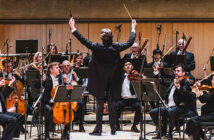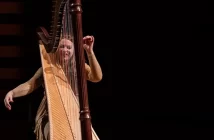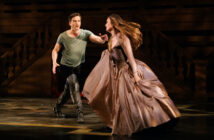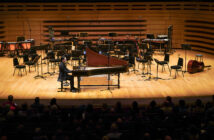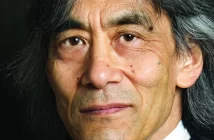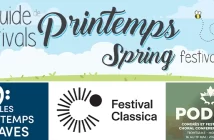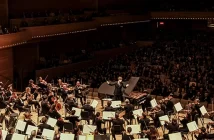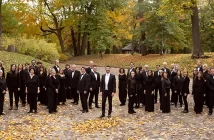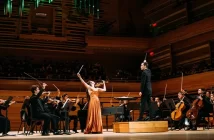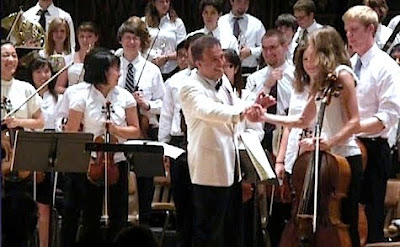
Summer Festivals
Round Top Festival Institute, 2010
Never underestimate the dreams of a concert pianist – especially those of an adopted son of Texas!
Van Cliburn, you say? Yes, he had an impossible dream and realized it when he won the Tchaikovsky International Piano Competition in Moscow in 1958, but there is another, lesser-known, Texas pianist who dreamed big and succeeded; James Dick, who was born in Hutchinson, Kansas, attended the University of Texas, and has lived in Texas ever since, built his own concert hall and music festival, in one of the least likely places – Round Top, Texas, population 77.
Each summer, the Round Top Festival Institute brings together 85 gifted young musicians with a faculty comprised mostly of leading members of the Dallas and Houston Symphony Orchestras. This year, the little festival that could – and did – celebrated its fortieth anniversary.
Brahms, Tchaikovsky and Some Rarely Heard Classical Treasures
The afternoon concert I attended was conducted by Christoph Campestrini of Austria and featured music by Brahms and Tchaikovsky.
I found the playing of these young musicians not only enthusiastic, but remarkably secure – even virtuosic, when called for by the music. The horn solo in the slow movement of Tchaikovsky’s Fifth Symphony was played flawlessly and with unusual maturity, and the double bass playing was exceptional for its beauty of tone and accuracy of intonation. And what a concertmaster! Nazig Tchakarian led with both grace and commitment. She will be an asset to any orchestra she chooses to join. Brahms’ Double Concerto featured two outstanding faculty members – violinist Federico Agostini and cellist Emilio Colón – and the orchestra provided a well-balanced accompaniment.
The evening concert featured a mix of faculty artists and outstanding students in music that for the most part is rarely heard. I had never come across D’Indy’s Chanson et Danses for Wind Septet Op. 80 and was mesmerized by its Straussian sonorities and by its freshness. The figuration given to the two clarinets in the second movement had to be heard to be believed. Jean-Michel Damase’s 17 Variations for Wind Quintet Op.22 was equally inventive, with a healthy dose of humour added for good measure.
James Dreamed a Dream…
Having last visited Round Top many years ago, I was not prepared for the current quality of musicianship or for the uniqueness of the surroundings. The Festival Concert Hall, as I remember it, was very much a work in progress. It was little more than a barn with chairs, and plastic ones at that. Now it is a real and magnificent concert space seating about 1,100.
The concert hall grew with the festival itself. Instead of raising millions of dollars and then building the hall all at once, James Dick and his supporters built what they could each successive year with the money they had in the bank. Construction began in 1981 and continued until the concert space was essentially complete in 2007. James Dick is a dreamer but also a patient man: the important thing was not to do it quickly but to do it properly, and to do it without going bankrupt.
The Townsfolk Made That Dream a Reality…
The hall’s interior is constructed entirely of wood. And while the intricate designs were all selected by Dick, they were carved and put into place by local folk. The master carpenter was Larry Birkelbach, whose mentor was Arnold Prosifka.
One’s first impression of the Festival Concert Hall is of a church somewhere in Europe – perhaps Eastern Europe. But there is no altar. Only a stage designed for music. No acoustician is credited with designing the hall, but whoever conceived it got it exactly right. Individual instrumental timbres are accurate and clear in both soft and loud passages, and there is plenty of bass response. The hall easily supports both the large orchestra I heard in the afternoon concert, and the chamber ensemble I heard in the evening.
At the rear of the hall there are a small gift shop and two modest, but fascinating, museums. The day I visited, there were well-informed docents in each museum to guide patrons through the wonders close at hand.
The first museum is devoted to David Guion (1892-1981). Don’t know the name? Well, he was famous in his day and his music will probably live forever. He was the man who wrote Home on the Range and the Yellow Rose of Texas. He was born in West Texas, but lived most of his working life as a composer in New York. In later years, he lived in Dallas. The “Texas Cowboy Composer” he was called, and the room is filled with his music, recordings, photos and furniture.
The other museum is equally fascinating. Did you know there was Swedish royalty living in La Grange near Round Top, Texas? Catharina Oxehufwud and her husband Olof lived there years ago and many of their personal items have found their way into the museum. Among them is a beautiful chest dating from 1635.
There’s more. James Dick’s Round Top property has grown to 200 acres and includes many more buildings: Menke House – moved from its original site in nearby Hempstead; the Edythe Bates Old Chapel – formerly Travis Street Methodist Church in La Grange; and several residences for students and faculty.
The Dream Realized: A Gift that Will Hopefully Keep on Giving
The Festival Institute has quite literally put the town of Round Top on the map. It is now a destination – with shops featuring the work of local artists and craftsmen; excellent restaurants; and B&Bs for those staying overnight – rather than a town with barely more than a post office and a gas station. Certainly, local folk patronize these businesses, but surely concert traffic can’t be discounted.
And yet, getting patrons to drive the 100 miles or so from either Austin or Houston is not as easy as it might seem. Day-trippers will find the festival attractive for afternoon concerts, but evening performances – unless one is staying overnight – perhaps not so much. Leaving Round Top, post-concert, at 10 pm to drive a second-class highway for 1 ½ to two hours may be an unwelcome challenge for many music-lovers; the evening concert I attended had an audience of approximately 50 – granted, the programme was somewhat esoteric – whereas for the afternoon concert, the hall was about 70% full!
Perhaps the way to go, whenever possible, is to avoid presenting evening concerts at this festival. And why aren’t there more Sunday concerts? Surely Sunday afternoon is prime time for concerts at a summer music festival!
Paul E. Robinson is the author of Herbert von Karajan: the Maestro as Superstar, and Sir Georg Solti: His Life and Music, both available at Amazon.com.
Photo by Marita


